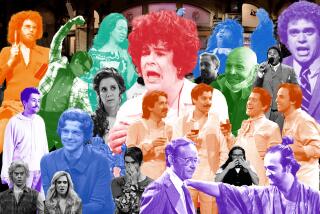Arts Students Follow Different Drummer in Revival of Play
At the School for Creative and Performing Arts in San Diego, no one finds it unusual that an African-American, a Latino and two white students hold down the four top roles in an upcoming revival of “Flower Drum Song,” a musical about San Francisco’s Chinatown during the 1950s.
Non-traditional casting is just part of the milieu that students and teachers take for granted at a school where the academic focus draws students voluntarily from all over the city to result in an integrated campus.
The play’s the thing, but the arts school aims to teach not only acting and production. Instructors also want students to relate drama to larger societal issues such as ethnic and gender stereotyping and interpretation of dated material in a modern context.
In tackling “Flower Drum Song,” resource teacher Ole Kittleson, a veteran instructor at the school and a well-known actor in local theatrical productions, knew he would face issues ranging from how to handle makeup to whether the 1950s musical presents an outdated and stereotypical view of Chinese-Americans. The play opens Thursday.
The selection by any school of a musical takes into account the usual dramatic and instructional possibilities, such as the number of male-female roles, the melodic style of the music and the ability of the school orchestra to handle a specific score.
But, at the performing arts school, the considerations go beyond casting to the context of a play’s material and the extent to which it links to multiculturalism and ethnicity.
For example, there was the national dispute last year over the British musical Miss Saigon, when Asian-American groups protested both the casting of a white actor to play the Eurasian lead on Broadway and the subservient role of Asians to whites as part of the story. It symbolized the cultural mine field that even a contemporary high school teacher has to think about.
Kittleson chose to do “Flower Drum Song,” a love story known for such songs as “I Enjoy Being a Girl” played out against a backdrop of cultural clash between first-and second-generation Chinese-Americans over Americanization, as part of the school’s exploration of ethnic issues.
“That’s one of our goals at SCPA, to try and salute different cultural groups with plays that have a universal theme,” Kittleson said.
But Kittleson quickly decided that, because of the school’s mandate to have ethnically mixed casts, no non-Asian student in the musical would be given makeup and theatrical eye treatments such as arched eyebrows to “look” Asian.
Both he and colleague Priscilla Allen were well aware of the potentials and perils in doing “Flower Drum Song” in the 1990s, having starred in a 1962 Starlight production of the Rogers and Hammerstein musical in which the almost all-white cast was completely made up to “look” Chinese.
“My decision was to have everyone look attractive, maybe add a wig or two to suggest the age or ethnicity in some cases, and let the audience suspend its disbelief after five minutes of watching the players,” Kittleson said. “To do otherwise would be like having non- African-Americans in blackface, which we didn’t do when we cast whites for some parts of ‘The Wiz,’ ” originally an all-black musical based on “The Wizard of Oz.”
Senior Jonathan Winn, a white student who plays one of the main roles, said that “by not having Asian makeup or costumes, we’re not being offensive. . . . To make us look like somebody we’re not, would be a real problem. Everyone knows that we don’t have enough Asian students at the school to cast the show with all Asians, even if we wanted to.”
Chandra Reid, the black editor of the school’s student newspaper, said that non-traditional casting, in which blacks, whites, Asians and Latinos play other ethnics, is one of the school’s strengths because it minimizes ethnic tensions that otherwise might disrupt a campus whose student body is 51% white, 33% black, 9% Latino, 5% Filipino and 2% Asian.
The special nature of the school insulates it from the criticism directed at amateur and professional companies that continue to cast white actors for any nonwhite roles. Minority advocates say that nonwhites need to be given first crack at any ethnic role because they traditionally have been given no chance to be cast for roles considered “white” or non-ethnic.
“If there were to be a revival of ‘Flower Drum Song’ on Broadway today, I would expect the call to go out for all Asian actors, and I’d be surprised if that would not be the case,” Allen said.
In concert with the lack of ethnic makeup, none of the characters uses artificial dialect to mimic the stereotypical way that Asian-American speech has often been portrayed in plays and movies.
“We aren’t going to have pigeon talk,” Kittleson said. Added Winn, “We aren’t mixing Ls and Rs; I am going to speak in proper, articulate speech, as I expect my character would do.”
As would most professional actors, the student actors spend most of their time trying to understand their individual roles and do not concentrate on the wider issues of cultural context.
“I prepare by reading the script over and over, thoroughly,” said junior Kianga Lee, an African-American who plays Madam Liang in the musical. “I know there is a close linkage between the (Chinese) family members in the play, so I have to make myself as close to the character as possible in showing that.”
Lee spent a month in China as an exchange student two years ago and her family also hosted a Chinese student.
“I learned a lot of things about China from our student and from going there,” Lee said. “Things are very different there compared to America, the way that a father decides on” whom a son or daughter should marry.
Winn said that “it’s not my responsibility to interpret an entire race or culture, but to try and see what my character is feeling and find his motif.”
However, Kittleson and the students do see their participation in “Flower Drum Song” as a learning experience about Chinese culture, although all concede that any Broadway play has its limits regarding historical accuracy. Absent background reading on the history of Chinese in the United States, there will be shortcomings both for participants and the audience.
“I don’t really know the reality of Chinatown today,” Winn said. “I don’t know” how much of the play is stereotypical, “but we’re playing (it) as close to the script as possible.”
Kittleson related one line where the Chinese father tells his son he has just been robbed after leaving a bank.
“What did the robber look like?” the son asks the father. The father replies, “Don’t ask me, all white men look alike.”
“That line will get a laugh,” Kittleson said, “but will it offend some people? Probably. I don’t know for sure.”
Cori Konishi, an Asian-American ninth-grader who is in the musical’s chorus, finds the characters “realistic, given that it’s a musical,” but less so based on real life.
“It’s stereotypical in a sense (by today’s standards) but for the era in which it was written, perhaps not as much,” she said.
Terry O’Donnell, a music professor at San Diego State University, agreed with that characterization, calling “Flower Drum Song” “gentle in its universal point of view that each generation can have valid beliefs and can come to an agreement about staying together.
“At bottom, it’s traditional musical theater with tunes that are easily memorized.”
For the creative arts school, that’s the bottom line as well.
“Once you get on stage, the adrenaline starts pumping, and you forget about all these issues,” Winn said. “You just want to perform.”
More to Read
The biggest entertainment stories
Get our big stories about Hollywood, film, television, music, arts, culture and more right in your inbox as soon as they publish.
You may occasionally receive promotional content from the Los Angeles Times.










